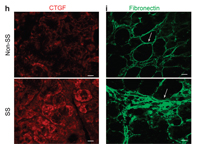GSDM-Led Team Identifies Molecular Explanation for Sjogren’s

A collaborative research team led by GSDM Professor of Molecular & Cell Biology and Associate Dean for Research Dr. Maria Kukuruzinska has identified a molecular explanation for at least a subset of cases of the disabling autoimmune disease Sjogren’s Syndrome. The team’s findings are published in the journal Laboratory Investigation.
Sjogren’s Syndrome (SS) is a complex autoimmune disease manifested by defective salivary and lacrimal gland function. The most common symptoms of SS are dry mouth and dry eyes, which can lead to dental cavities, vision problems, and thrush. SS also carries an increased risk for developing B cell lymphoma.
While the cause of SS has remained controversial, the prevailing dogma has been that immune system pathology drives the disease. The manuscript now provides evidence that defects in cell polarity, or cell structure, are the likely culprits in at least some cases of SS.
The collective expertise of the international multidisciplinary team of investigators—which included oral & maxillofacial surgeons, oral & maxillofacial pathologists, immunologists, as well as developmental, molecular, and cell biologists—facilitated the application of studies with models to human SS patients.
The authors showed that structural abnormalities acquired during embryonic development of the model salivary submandibular gland (SMG) mimic defects observed in embryonic SMGs from non-obese diabetic models predisposed to develop SS after birth. Furthermore, the authors provide a molecular explanation for SS by identifying dysregulation of the Hippo signaling pathway, a central pathway regulating the organ size, cell proliferation, and differentiation, as an underlying basis of this disease, which they validate in human labial biopsy specimens from SS patients.
The authors postulate that defects in embryonic salivary cell polarity may have a role later in adult tissue homeostasis and be exacerbated by hormonal conditions and/or environmental insults, potentially explaining the frequently observed late onset of this disease.
Submitted by GSDM Communications.